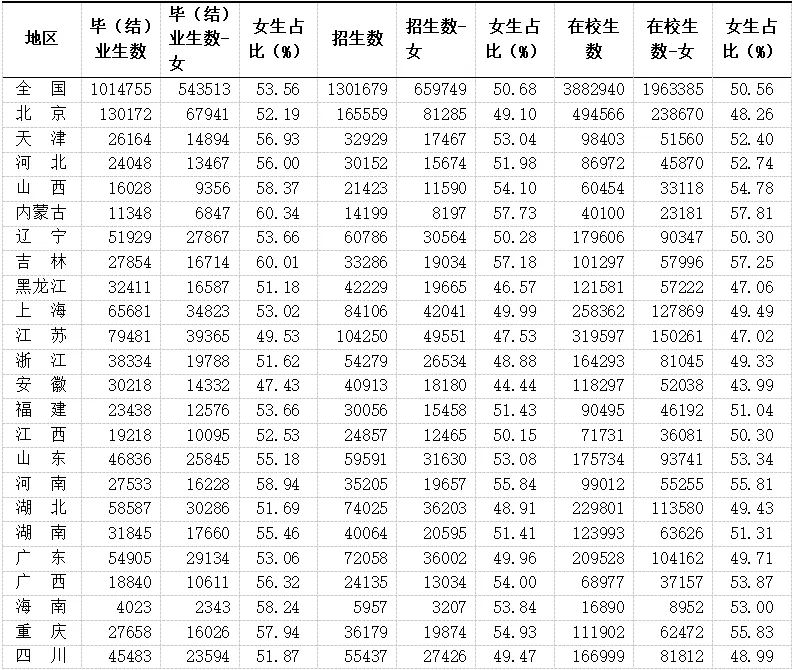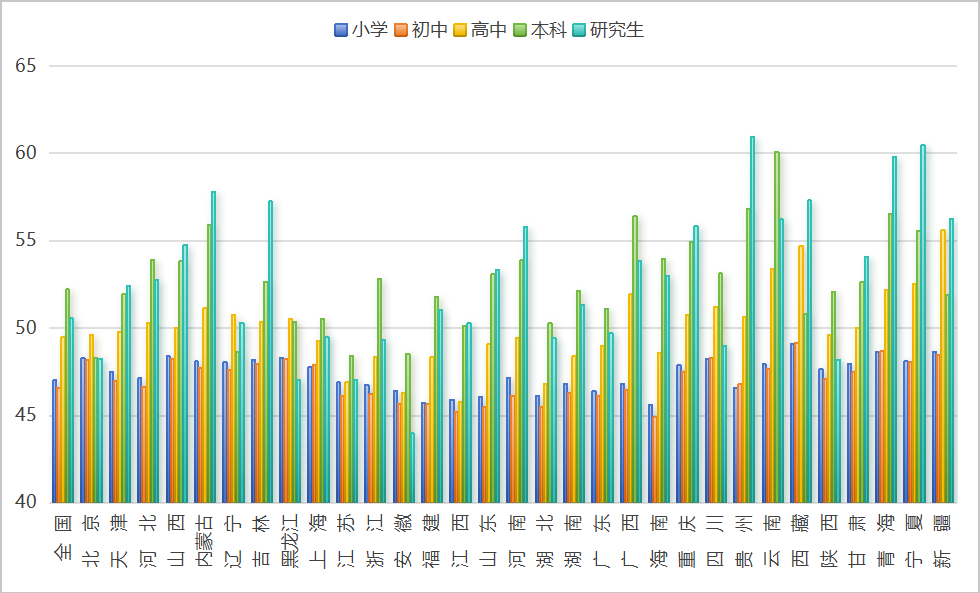In 2022, among the 4.68 million national undergraduate admissions, the proportion of females was approximately 63%. Why do females overwhelmingly surpass males at the undergraduate level?
Overall, there are fewer females than males at the vocational level, but significantly more females than males at the undergraduate level. At the graduate level, female master’s students exceed male students, while female doctoral students are fewer than males. The highest proportion of females is at the undergraduate level.
What are the reasons? First, without a doubt, it is due to the significant improvement in women’s educational rights; the second reason is the gender character advantages of females, such as being more diligent, self-disciplined, and mature; third, the increasingly standardized nature of the college entrance examinations, with test questions becoming more fixed, focusing on thoroughness and detail, which aligns well with traits typically associated with femininity. Relatedly, in recent years, there has been an oversupply of liberal arts majors in undergraduate admissions. In fact, this phenomenon is a global trend.
There are still many questions to be answered, perhaps we can glean some insights from the data report analysis below.
Over the past decade, Chinese women have achieved remarkable historical breakthroughs in higher education. When we look at the educational data from 2013 to 2023, a magnificent picture of the rise of women’s education unfolds. This is not just a change in numbers, but a profound transformation of the entire social gender structure.
01The opportunity for females to attend university is 1.7 times that of males
By 2023, the proportion of females among national undergraduate students has risen to 52.22%, marking females as the “main force” in university campuses. Even more striking is the undergraduate admission data from 2022, where the proportion of females reached an astonishing 63%! This means that among every 100 new students entering university, 63 are females, while only 37 are males. In other words, females have 1.7 times the opportunity for university education compared to males.
From 2013 to 2022, this ratio steadily increased from 54.92% to 63%, an increase of 8.08 percentage points. This is not merely a simple numerical change, but a fundamental shift in the distribution of educational opportunities, highlighting the comprehensive enhancement and significant progress of women’s educational rights.
 Trend of Female Proportion in National Undergraduate Admissions from 2013 to 2022Particularly noteworthy is the “highland of female education” in the southwestern region——Yunnan, Guizhou, and Guangxi, where the proportion of females in undergraduate admissions astonishingly exceeds 60%. Yunnan even set a national record, with the female proportion in undergraduate admissions reaching 81.73% in 2022! Behind these numbers are countless resilient stories of western girls changing their destinies through education.02Females make up over half of the national graduate student population
Trend of Female Proportion in National Undergraduate Admissions from 2013 to 2022Particularly noteworthy is the “highland of female education” in the southwestern region——Yunnan, Guizhou, and Guangxi, where the proportion of females in undergraduate admissions astonishingly exceeds 60%. Yunnan even set a national record, with the female proportion in undergraduate admissions reaching 81.73% in 2022! Behind these numbers are countless resilient stories of western girls changing their destinies through education.02Females make up over half of the national graduate student population
The gender balance in higher education is no longer limited to the undergraduate level. In 2023, the proportion of females among national graduate students has reached 50.56%, marking a historic breakthrough for women in high-level talent cultivation. The proportion of females at the master’s level increased from 51.38% in 2013 to 52.89% in 2022, while the proportion of females at the doctoral level rose from 36.90% to 41.91% over the decade, an increase of 5.01 percentage points.

 Proportion of Females Among Graduate Students in Higher Education Institutions (2023)This change signifies that more and more women are breaking through to the top of the academic pyramid, redefining the gender composition of academic elites.Qinghai, Ningxia, and Guizhou and other western provinceshave even surpassed 60% in the proportion of females at the graduate level, creating a rare phenomenon in global higher education gender structure.
Proportion of Females Among Graduate Students in Higher Education Institutions (2023)This change signifies that more and more women are breaking through to the top of the academic pyramid, redefining the gender composition of academic elites.Qinghai, Ningxia, and Guizhou and other western provinceshave even surpassed 60% in the proportion of females at the graduate level, creating a rare phenomenon in global higher education gender structure. Proportion of Females Among Students in Various Educational Levels by Region in 2023 (%)03Middle School and College Entrance Examinations Become Key Nodes for Females to Achieve a Turnaround
Proportion of Females Among Students in Various Educational Levels by Region in 2023 (%)03Middle School and College Entrance Examinations Become Key Nodes for Females to Achieve a Turnaround
From basic education to higher education, the gender ratio shows a dramatic reversal: at the elementary level, there are 116.1 boys for every 100 girls, at the middle school level, 115.66 boys for every 100 girls, at the high school level, 98.37 boys for every 100 girls, but at the undergraduate level, there are only 58.7 boys for every 100 girls!
 This transformation from “disadvantage” to “advantage” showcases the “latecomer advantage” of females in educational competition. The middle school and college entrance examinations have become key nodes for females to achieve a turnaround——during the transition from middle school to high school, the national elimination rate for boys is about 17.29%; during the transition from high school to undergraduate, boys are again filtered out at a rate of 6.87%. This is not coincidental, but rather reflects the systematic advantages of females in learning attitudes, self-discipline, and overall quality.
This transformation from “disadvantage” to “advantage” showcases the “latecomer advantage” of females in educational competition. The middle school and college entrance examinations have become key nodes for females to achieve a turnaround——during the transition from middle school to high school, the national elimination rate for boys is about 17.29%; during the transition from high school to undergraduate, boys are again filtered out at a rate of 6.87%. This is not coincidental, but rather reflects the systematic advantages of females in learning attitudes, self-discipline, and overall quality.
Source: China Education Online
If you have any questions, please contact the author
